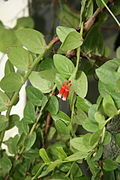Description
They are epiphytic or terrestrial shrubs. Alternate leaves, petiolate, coriaceous, pinnatinervias or plinervias. Subfasciculate or racemose inflorescences, axillary or terminal, with few to numerous flowers, bibracteolate pedicels, deciduous bracteoles; hypanthium articulated with the pedicel, cylindrical or campanulate; calyx limb erect and patent, (3–) 5-lobed, lobes subacute and triangular; corolla subcylindrical or elongated urceolate, 5-parted, triangular lobes, acute to subacute; stamens usually 10, equal, usually about half as long as corolla, filaments free or connate, anthers strong with strongly granular thecae, tubules nearly as long as anther sacs, or laterally connate or fused to form a tubule simple, rarely completely free, opening by elongated free or fused slits, introrse; style threadlike and about the same length as the corolla or longer, ovary 5-locular. The fruit is a berry with numerous small seeds. [1]
This page is based on this
Wikipedia article Text is available under the
CC BY-SA 4.0 license; additional terms may apply.
Images, videos and audio are available under their respective licenses.






